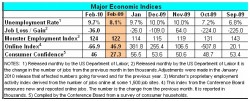9.7 percent and holding steady. Net job loss in February 2010: 36,000. Net job loss in February 2009: 726,000.
 That’s the top line of the monthly Labor Department’s employment numbers for February. The results surprised most economists who had been expecting a higher job loss because of the snowstorms that crippled big parts of the U.S. last month.
That’s the top line of the monthly Labor Department’s employment numbers for February. The results surprised most economists who had been expecting a higher job loss because of the snowstorms that crippled big parts of the U.S. last month.
The good news, according to a Wall Street Journal analysis, is that but for the weather, the numbers would have shown an increase in jobs during the month. Citing Morgan Stanley economist David Greenlaw, the Journal says, “payrolls would’ve increased sharply last month — and would be expected to show strong growth in the March (employment) report.”
So take that you naysayers and prophets of doom. The U.S. may not exactly be booming, but it appears those predictions of job growth in the second quarter of 2010 are spot on.
Americans, however, aren’t feeling the same confidence that economists and labor analysts are. Consumer confidence, as measured by The Conference Board, dropped precipitously in February, free-falling from 56.5 in January to 46 in February. The last time the venerable index took that big a plunge was in February a year ago, when it dropped 12 points to 25.3.
There are all sorts of explanations for the plunge after three months of steady, if slow increases. Chief among them is the outlook for employment.
“Concerns about current business conditions and the job market pushed the Present Situation Index (one of the elements used to calculate the confidence index) down to its lowest level in 27 years. Consumers’ short-term outlook also took a turn for the worse, with fewer consumers anticipating an improvement in business conditions and the job market over the next six months. Consumers also remain extremely pessimistic about their income prospects,” said the Board’s Lynn Franco, director of its Consumer Research Center.
This morning’s numbers from the U.S. Bureau of Labor Statistics provide some explanation for American’s pessimism. Of the 14.9 million unemployed, 40 percent have been out of work for seven months or more. When you add in the 2.5 million people out of work, but not counted as unemployed because they gave up, and the 8.8 million (an increase of 700,000 from January) who are working part-time because they can’t find a full time job, then the full effect of the recession becomes apparent.
Together, those numbers add up to 26.2 million Americans who are out-of-work or underemployed. And those are only the official numbers.
For those with jobs, the BLS says the average per hour wage was $22.46, an increase of 1.9 percent in the last 12 months. Overtime hours and total weekly hours worked declined during the month.
Now, instead of closing on that sour note, look at the stats for temporary workers: February showed a gain in that sector of 47,500 jobs. The 2.009 million temp jobs during the month was particularly good news, since it is a gain of 76,000 jobs over the 1.933 million temp jobs in February 2009.
Like the robin, increases in temp jobs is considered a harbinger of permanent hiring to come.